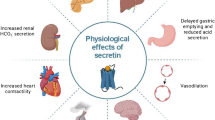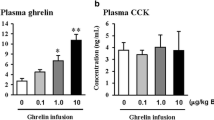Abstract
Background
Intraduodenal administration of peptone prepared from soybean β-conglycinin (BconP) stimulates cholecystokinin (CCK) secretion from enteroendocrine cells, and suppresses food intake in rats. However, the sensing mechanism of BconP by CCK-producing cells is unknown.
Aim of the study
We investigated signal transduction pathways mediating CCK secretion in response to BconP in the murine CCK-producing cell line, STC-1.
Methods
STC-1 cells were seeded in 48-well culture plates until sub-confluent and CCK secretion was examined under various conditions. CCK concentration was determined by the enzyme immunoassay.
Results
BconP dose-dependently induced CCK secretion in STC-1 cells. Treatment with BAPTA-AM, an intracellular Ca2+ chelator, reduced BconP-induced CCK secretion, however, removal of extracellular Ca2+ did not affect the secretory response. Treatment with 2-amino borate (2-APB) reduced CCK releasing responses, suggesting the involvement of IP3. In addition, BconP failed to induce CCK secretion after treatment with the Gαq protein inhibitor (YM-254890).
Conclusion
These results indicate that Gαq pathway is responsible for BconP-induced CCK secretion in STC-1 cells, and suggest the involvement of a Gαq-coupled GPCR(s) in dietary peptide sensing in enteroendocrine cells.


Similar content being viewed by others
References
Bootman MD, Collins TJ, Mackenzie L, Roderick HL, Berridge MJ, Peppiatt CM (2002) 2-aminoethoxydiphenyl borate (2-APB) is a reliable blocker of store-operated Ca2+ entry but an inconsistent inhibitor of InsP3-induced Ca2+ release. FASEB J 16(10):1145–1150
Choi S, Lee M, Shiu AL, Yo SJ, Aponte GW (2007) Identification of a protein hydrolysate responsive G protein-coupled receptor in enterocytes. Am J Physiol Gastrointest Liver Physiol 292(1):G98–G112
Choi S, Lee M, Shiu AL, Yo SJ, Hallden G, Aponte GW (2007) GPR93 activation by protein hydrolysate induces CCK transcription and secretion in STC-1 cells. Am J Physiol Gastrointest Liver Physiol 292(5):G1366–G1375
Dockray GJ (2003) Luminal sensing in the gut: an overview. J Physiol Pharmacol 54(Suppl 4):9–17
Hira T, Hara H, Aoyama Y (1999) Stimulative effect of a casein hydrolysate on exocrine pancreatic secretion that is independent of luminal trypsin inhibitory activity in rats. Biosci Biotechnol Biochem 63:1192–1196
Hira T, Elliott AC, Thompson DG, Case RM, McLaughlin JT (2004) Multiple fatty acid sensing mechanisms operate in enteroendocrine cells: novel evidence for direct mobilization of stored calcium by cytosolic fatty acid. J Biol Chem 279:26082–26089
Hirasawa A, Tsumaya K, Awaji T, Katsuma S, Adachi T, Yamada M, Sugimoto Y, Miyazaki S, Tsujimoto G (2005) Free fatty acids regulate gut incretin glucagon-like peptide-1 secretion through GPR120. Nat Med 11:90–94
Nemoz-Gaillard E, Bernard C, Abello J, Cordier-Bussat M, Chayvialle JA, Cuber JC (1998) Regulation of cholecystokinin secretion by peptones and peptidomimetic antibiotics in STC-1 cells. Endocrinology 139:932–938
Nishi T, Hara H, Hira T, Tomita F (2001) Dietary protein peptic hydrolysates stimulate cholecystokinin release via direct sensing by rat intestinal mucosal cells. Exp Biol Med 226:1031–1036
Nishi T, Hara H, Tomita F (2003) Soybean beta-conglycinin peptone suppresses food intake and gastric emptying by increasing plasma cholecystokinin levels in rats. J Nutr 133:352–357
Reimann F, Gribble FM (2002) Glucose-sensing in glucagon-like peptide-1-secreting cells. Diabetes 51:2757–2763
Reimann F, Williams L, da Silva Xavier G, Rutter GA, Gribble FM (2004) Glutamine potently stimulates glucagon-like peptide-1 secretion from GLUTag cells. Diabetologia 47:1592–1601
Snow ND, Prpic V, Mangel AW, Sharara AI, McVey DC, Hurst LJ, Vigna SR, Liddle RA (1994) Regulation of cholecystokinin secretion by bombesin in STC-1 cells. Am J Physiol Gastrointest Liver Physiol 267:G859–G865
Takasaki J, Saito T, Taniguchi M, Kawasaki T, Moritani Y, Hayashi K, Kobori M (2004) A novel Galphaq/11-selective inhibitor. J Biol Chem 279:47438–47445
Acknowledgments
This work was funded by Bio-oriented Technology Research Advancement Institution (Japan). We thank Astellas Pharma Inc. for providing YM-254890.
Author information
Authors and Affiliations
Corresponding author
Rights and permissions
About this article
Cite this article
Hira, T., Maekawa, T., Asano, K. et al. Cholecystokinin secretion induced by β-conglycinin peptone depends on Gαq-mediated pathways in enteroendocrine cells. Eur J Nutr 48, 124–127 (2009). https://doi.org/10.1007/s00394-008-0764-1
Received:
Accepted:
Published:
Issue Date:
DOI: https://doi.org/10.1007/s00394-008-0764-1




